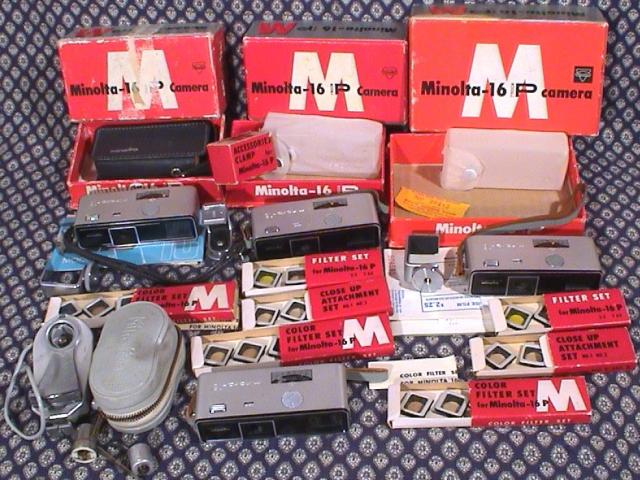
introduction | chrome 10-160 | chrome 10-200 | chrome (chart) | chrome 10-160 | 16Ps | accessories

Along side the Minolta 16 II the Minolta 16P was launched in 1960. A simplified camera with a single shutter speed of 1/100 s and with f-stop 3.5-16 which are also marked with icons for bright sunshine, hazy sun, cloudy bright, and cloudy dull.
The dial on top of the camera set film speed and the aperture was set against the dual f-stop and symbols. Some have stops at ASA 10, 25, 40, 80, 200 e.g. 210587 others had stops at ASA 10, 32, 40, 80, 160 e.g. 219350 & 240896 (See ASA Ranges). An exposure guide is etched on the back of the camera for quick reference.
The body does not collapse and so is longer than the Minolta 16 and the push-pull film advance replaced by a thumb wheel. The bonus is that the film does not advance every time the camera is used to frame a subject and the shutter is locked until the film is advanced - no double exposures and no lost frames. The three element lens is of good quality, very sharp and excellent for scenic and group shots.
It has a built-in PC contact and tripod socket. The combination flash bracket/tripod adapter was also an accessory for the 16EE and 16EEII cameras.
The point of focus for the three element lens was fixed at 16 feet. The depth-of-field is adequate and controllable by aperture selection. There are also two auxiliary lens for close up. No.1 was for focusing at about 1.2m (4 feet), and No.2 0.7m (2.5 feet). Filters included a UV, Y48 (yellow), 80A, 81B, ND (4x) and 1A. The filters and lenses used a bayonet system and twisted into place on the lens surround.
The manuals are un-dated and say ‘Chiyoda Kogaku Seiko K. K. Minolta-16 Model P’. This is due to Chiyoko becoming The Minolta Camera Company in 1962.
In the united Kingdom, in 1961 the camera and case cost about £9, rising to about £12 in 1965, after which it would appear to have been withdrawn. The last list price in the USA was $26.90.
The same red box style was used throughout the world, but the smallest box is from Japan, the largest from the USA.
Case style varied over the 5 years of production. The original is a is a button down leather case similar to that of the 16EE/16EEII and the wrist strap is leather. Later cameras have a button down translucent case which is now usually ready to break into small pieces. The wrist strap changes to a flat strip of leather, green on one size and hide on the other,
| Years of production | 1960-1965 |
| Lens | 25mm Rokkor |
| Aperture | f3.5-16 |
| Shutter Speeds | 1/100 |
| ASA Range | 10, 25, 40, 80, 200 (e.g. 210587) or 10, 32, 40, 80, 160 (e.g. 175551, 257047) |
| Flash sync. | F class bulb electronic flash |
| Negative Size | 10x14mm |
| Finishes | chrome |
| Supplied | case, wrist strap |
| Manuals | English: |
| Dimensions | 104mm (W) x 44mm (D) x 27mm (H) |
| Filters | UV, Y48(Yellow), 1A-skylight (1.1x), 80A (3.2x), 81B (1.3x). ND (4x) |
| Auxiliary lenses | Close-up #1 (3-5 ft), #2 (1.5-3.5 ft) |
| Flash and Tripod Clamp | C clamp holds flash unit and includes a tripod socket |
| Flash | Baby Flash |
| Projector | Mini 16 |
| Enlarger | Minolta Mini Enlarger with f3.5 25mm Rokkor lens, stops down to f:11, 100watt bulb, enlargements up to 5x7 inches. |
| Developing Tank |
The f/3.5 22mm Rokkor lens provides extreme depth of field. You are in sharp focus from 8.7 feet to 158 feet at f/5.6
For close-ups, or, for subjects in the distance, it is recommended to use the close-up lens attachment (No.1 or No.2).
| Lens Opening | Without Close-up Lens | With No. 1 Close-up Lens | With No. 2 Close-up Lens |
| F 3.5 | 10.5 ft. - 37 ft. | 3.5 ft. -4.5 ft. | 2.1 ft. - 2.5 ft. |
| F 4 | 10 ft. - 45.5 ft | 3.4 ft. - 4.6 ft. | 2.1 ft. - 2.5 ft. |
| F 5.6 | 8.7 ft. - 158 ft. | 3.3 ft. - 5 ft. | 2 ft. - 2.6 ft. |
| F 8 | 7.3 ft. - infinity. | 3 ft. - 5.6 ft. | 2 ft. - 2.7 ft. |
| F 11 | 6 ft. - infinity. | 2.8 ft. - 6.6 ft. | 1.9 ft. - 3 ft. |
| F 16 | 4.7 ft. - infinity. | 2.5 ft. - 9.7 ft. | 1.7 ft. - 3.4 ft. |
Last Updated on 7th February 2005